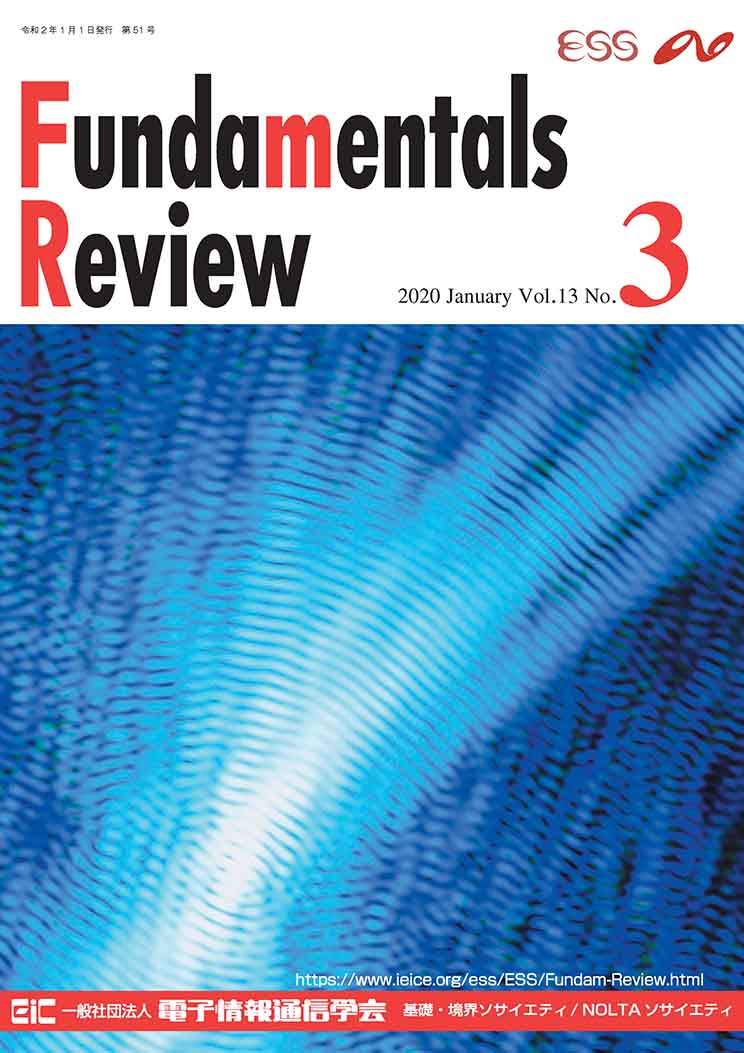Volume 13, Issue 3
Displaying 1-25 of 25 articles from this issue
- |<
- <
- 1
- >
- >|
Cover
-
2020 Volume 13 Issue 3 Pages 0
Published: January 01, 2020
Released on J-STAGE: January 01, 2020
Download PDF (368K)
Table of Contents
-
2020 Volume 13 Issue 3 Pages 177
Published: January 01, 2020
Released on J-STAGE: January 01, 2020
Download PDF (206K)
Preface
-
2020 Volume 13 Issue 3 Pages 178-179
Published: January 01, 2020
Released on J-STAGE: January 01, 2020
Download PDF (471K)
Review Papers
Proposed by SIP (Signal Processing)
-
2020 Volume 13 Issue 3 Pages 180-186
Published: January 01, 2020
Released on J-STAGE: January 01, 2020
Download PDF (1052K)
Proposed by NLP (Nonlinear Problems)
-
2020 Volume 13 Issue 3 Pages 187-196
Published: January 01, 2020
Released on J-STAGE: January 01, 2020
Download PDF (1655K)
Proposed by IT (Information Theory)
-
2020 Volume 13 Issue 3 Pages 197-208
Published: January 01, 2020
Released on J-STAGE: January 01, 2020
Download PDF (1220K)
Proposed by US (Ultrasonics)
-
2020 Volume 13 Issue 3 Pages 209-216
Published: January 01, 2020
Released on J-STAGE: January 01, 2020
Download PDF (3139K)
Proposed by SITE (Social Implications of Technology and Information Ethics)
-
2020 Volume 13 Issue 3 Pages 217-230
Published: January 01, 2020
Released on J-STAGE: January 01, 2020
Download PDF (888K)
Proposed by RCC (Reliable Communication and Control)
-
2020 Volume 13 Issue 3 Pages 231-238
Published: January 01, 2020
Released on J-STAGE: January 01, 2020
Download PDF (1393K)
Miscellaneous Articles
ESS News
-
2020 Volume 13 Issue 3 Pages 239
Published: January 01, 2020
Released on J-STAGE: January 01, 2020
Download PDF (105K) -
2020 Volume 13 Issue 3 Pages 240-244
Published: January 01, 2020
Released on J-STAGE: January 01, 2020
Download PDF (1556K)
Let's go to IEICE Workshops!
-
2020 Volume 13 Issue 3 Pages 245
Published: January 01, 2020
Released on J-STAGE: January 01, 2020
Download PDF (460K) -
2020 Volume 13 Issue 3 Pages 245b-246
Published: January 01, 2020
Released on J-STAGE: January 01, 2020
Download PDF (598K) -
2020 Volume 13 Issue 3 Pages 246
Published: January 01, 2020
Released on J-STAGE: January 01, 2020
Download PDF (294K) -
2020 Volume 13 Issue 3 Pages 247
Published: January 01, 2020
Released on J-STAGE: January 01, 2020
Download PDF (226K) -
2020 Volume 13 Issue 3 Pages 247b-247
Published: January 01, 2020
Released on J-STAGE: January 01, 2020
Download PDF (226K) -
2020 Volume 13 Issue 3 Pages 247c-248
Published: January 01, 2020
Released on J-STAGE: January 01, 2020
Download PDF (430K) -
2020 Volume 13 Issue 3 Pages 248-249
Published: January 01, 2020
Released on J-STAGE: January 01, 2020
Download PDF (953K)
International Conference Report
-
2020 Volume 13 Issue 3 Pages 250-251
Published: January 01, 2020
Released on J-STAGE: January 01, 2020
Download PDF (566K) -
2020 Volume 13 Issue 3 Pages 252-253
Published: January 01, 2020
Released on J-STAGE: January 01, 2020
Download PDF (614K)
Winners' Voice
-
2020 Volume 13 Issue 3 Pages 254-255
Published: January 01, 2020
Released on J-STAGE: January 01, 2020
Download PDF (585K)
Hirosima Report
-
2020 Volume 13 Issue 3 Pages 256-258
Published: January 01, 2020
Released on J-STAGE: January 01, 2020
Download PDF (1224K)
Call for Papers
-
2020 Volume 13 Issue 3 Pages 259
Published: January 01, 2020
Released on J-STAGE: January 01, 2020
Download PDF (1022K)
-
2020 Volume 13 Issue 3 Pages 260-261
Published: January 01, 2020
Released on J-STAGE: January 01, 2020
Download PDF (339K)
Committees & Editors Notes
-
2020 Volume 13 Issue 3 Pages 262-264
Published: January 01, 2020
Released on J-STAGE: January 01, 2020
Download PDF (320K)
- |<
- <
- 1
- >
- >|
